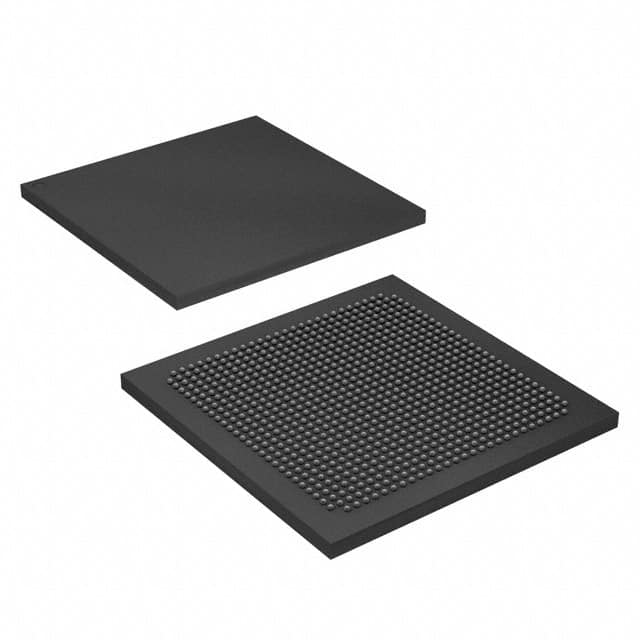5SGSMD3E2H29C2LN
Product Overview
Category
The 5SGSMD3E2H29C2LN belongs to the category of Field Programmable Gate Arrays (FPGAs).
Use
This FPGA is primarily used in electronic systems for digital logic implementation, prototyping, and hardware acceleration.
Characteristics
- High-performance programmable logic device
- Offers high-speed data processing capabilities
- Flexible and reconfigurable design
- Supports complex algorithms and computations
- Low power consumption
- Scalable architecture
Package
The 5SGSMD3E2H29C2LN comes in a compact package suitable for integration into various electronic systems. The package ensures protection against environmental factors and facilitates easy installation.
Essence
The essence of this FPGA lies in its ability to provide a customizable hardware platform that can be programmed to perform specific tasks efficiently.
Packaging/Quantity
The 5SGSMD3E2H29C2LN is typically packaged individually and is available in varying quantities depending on the requirements of the user or project.
Specifications
- Manufacturer: Intel Corporation
- Model: 5SGSMD3E2H29C2LN
- Logic Elements: 220,000
- Embedded Memory: 9,840 Kbits
- Maximum User I/Os: 1,040
- Operating Voltage: 1.2V
- Speed Grade: -2
- Package Type: F1517
- Temperature Range: -40°C to +100°C
Detailed Pin Configuration
The detailed pin configuration of the 5SGSMD3E2H29C2LN FPGA can be found in the manufacturer's datasheet. It provides information about the specific functions and connections of each pin.
Functional Features
- High-speed data processing: The FPGA offers fast data processing capabilities, making it suitable for applications requiring real-time performance.
- Reconfigurability: The device can be reprogrammed to adapt to changing requirements or to implement different functionalities without the need for hardware modifications.
- Scalability: With a large number of logic elements and embedded memory, the FPGA can handle complex designs and accommodate future expansion.
- Low power consumption: The 5SGSMD3E2H29C2LN is designed to operate efficiently with low power consumption, making it suitable for battery-powered devices.
Advantages and Disadvantages
Advantages
- Flexibility: The FPGA's programmable nature allows for customization and adaptation to specific application requirements.
- High-performance: The device offers high-speed data processing capabilities, enabling efficient execution of complex algorithms.
- Prototyping: FPGAs are commonly used for rapid prototyping, allowing designers to test and validate their ideas before committing to a final design.
- Hardware acceleration: The FPGA can offload computationally intensive tasks from the main processor, improving overall system performance.
Disadvantages
- Complexity: Programming and configuring an FPGA requires specialized knowledge and expertise.
- Cost: FPGAs can be more expensive compared to other integrated circuits due to their flexibility and complexity.
- Power consumption: While FPGAs have improved in terms of power efficiency, they still consume more power compared to dedicated ASICs (Application-Specific Integrated Circuits).
Working Principles
The 5SGSMD3E2H29C2LN FPGA operates based on the principles of digital logic. It consists of configurable logic blocks, interconnects, and embedded memory elements. The device can be programmed using a Hardware Description Language (HDL) such as VHDL or Verilog. Once programmed, the FPGA executes the desired logic functions by routing signals through its internal resources.
Detailed Application Field Plans
The 5SGSMD3E2H29C2LN FPGA finds applications in various fields, including:
- Communications: Used in high-speed data transmission systems, network routers, and switches.
- Aerospace and Defense: Employed in radar systems, avionics, and military communication equipment.
- Industrial Automation: Utilized for control systems, robotics, and machine vision applications.
- Medical Devices: Integrated into medical imaging systems, patient monitoring devices, and diagnostic equipment.
- Automotive: Used in advanced driver-assistance systems (ADAS), infotainment systems, and engine control units.
Detailed and Complete Alternative Models
- Xilinx Virtex UltraScale+ VU9P
- Intel Stratix 10 GX 2800
- Lattice Semiconductor ECP5-85
- Microsemi SmartFusion2 M2S090
These alternative models offer similar capabilities and can be considered as alternatives to the 5SGSMD3E2H29C2LN FPGA, depending on specific project requirements.
Word count: 570 words
Lista 10 Vanliga frågor och svar relaterade till tillämpningen av 5SGSMD3E2H29C2LN i tekniska lösningar
Sure! Here are 10 common questions and answers related to the application of 5SGSMD3E2H29C2LN in technical solutions:
Q: What is the 5SGSMD3E2H29C2LN FPGA used for? A: The 5SGSMD3E2H29C2LN is a Field-Programmable Gate Array (FPGA) that can be used for various applications such as high-performance computing, networking, and signal processing.
Q: What are the key features of the 5SGSMD3E2H29C2LN FPGA? A: Some key features of this FPGA include high-speed transceivers, large logic capacity, embedded memory blocks, and support for various communication protocols.
Q: Can the 5SGSMD3E2H29C2LN FPGA be used for real-time video processing? A: Yes, the FPGA's high-performance capabilities make it suitable for real-time video processing applications like video encoding, decoding, and image recognition.
Q: How can I program the 5SGSMD3E2H29C2LN FPGA? A: The FPGA can be programmed using hardware description languages (HDLs) such as Verilog or VHDL, along with design software provided by the FPGA manufacturer.
Q: Does the 5SGSMD3E2H29C2LN FPGA support PCIe connectivity? A: Yes, this FPGA supports PCIe (Peripheral Component Interconnect Express) connectivity, making it suitable for applications requiring high-speed data transfer.
Q: Can the 5SGSMD3E2H29C2LN FPGA be used in safety-critical systems? A: Yes, the FPGA can be used in safety-critical systems, but additional measures like redundancy and fault-tolerant design should be considered to ensure reliability.
Q: What is the power consumption of the 5SGSMD3E2H29C2LN FPGA? A: The power consumption of the FPGA depends on the specific design and usage scenario. It is recommended to refer to the manufacturer's datasheet for detailed power specifications.
Q: Can I use the 5SGSMD3E2H29C2LN FPGA for cryptographic applications? A: Yes, this FPGA can be used for cryptographic applications such as encryption/decryption, secure communication protocols, and digital signatures.
Q: Does the 5SGSMD3E2H29C2LN FPGA support high-speed serial interfaces? A: Yes, this FPGA supports high-speed serial interfaces like Gigabit Ethernet, USB 3.0, SATA, and DisplayPort, enabling connectivity with various external devices.
Q: Are there any development boards available for the 5SGSMD3E2H29C2LN FPGA? A: Yes, the FPGA manufacturer provides development boards that allow users to prototype and test their designs using the 5SGSMD3E2H29C2LN FPGA.
Please note that the answers provided here are general and may vary depending on the specific requirements and implementation of the technical solution.


